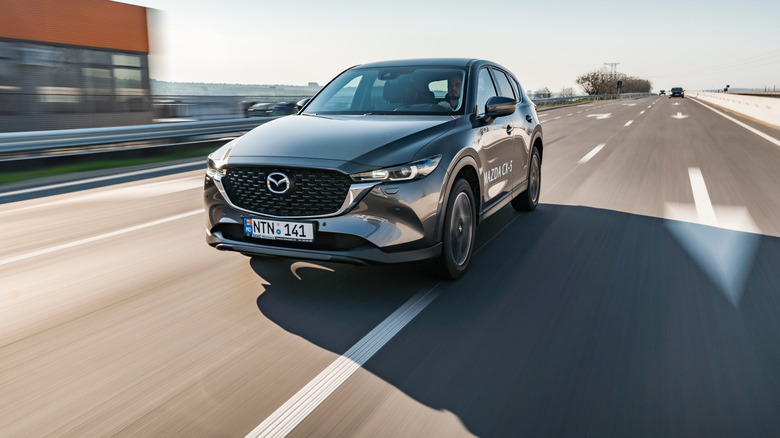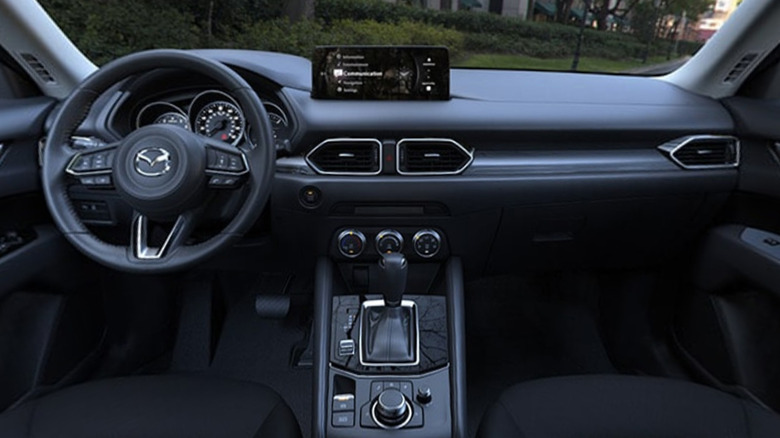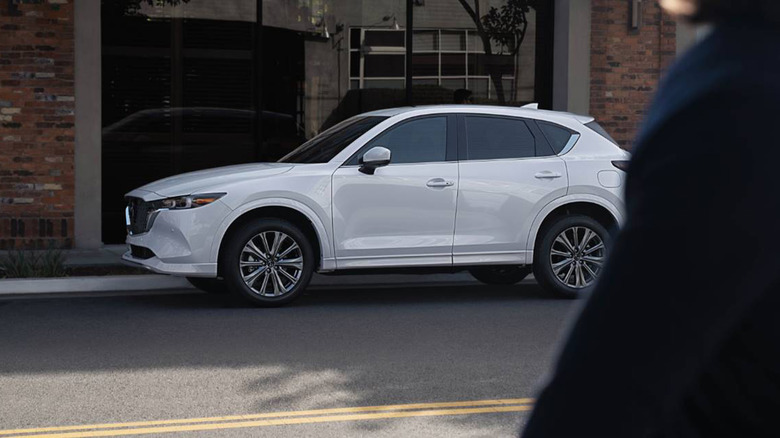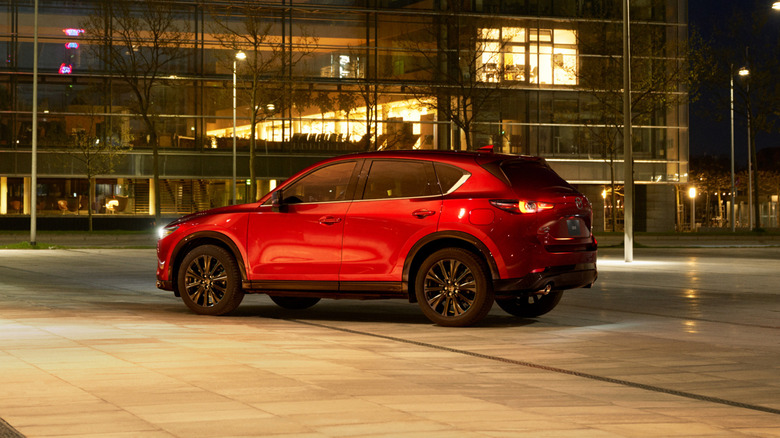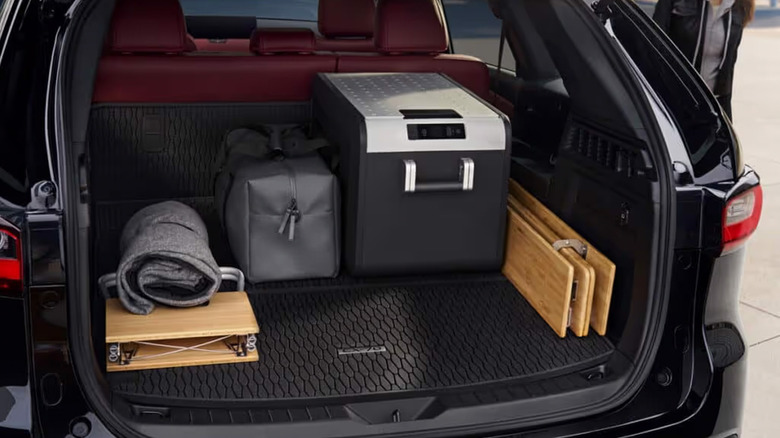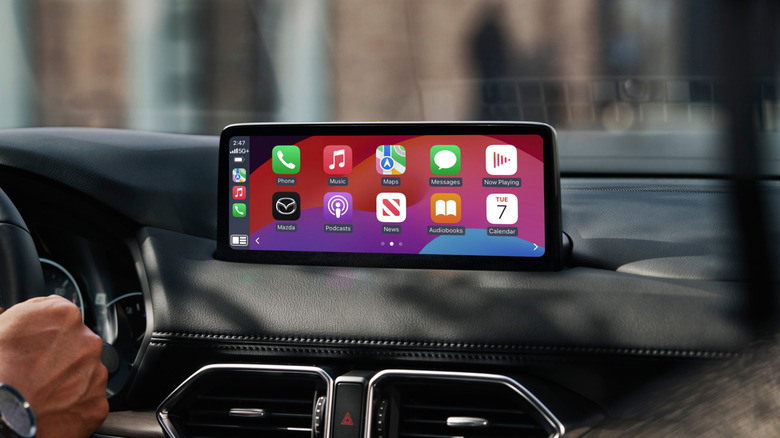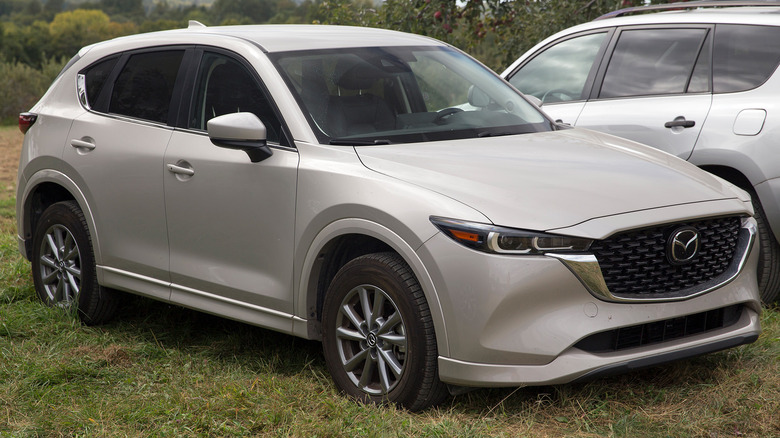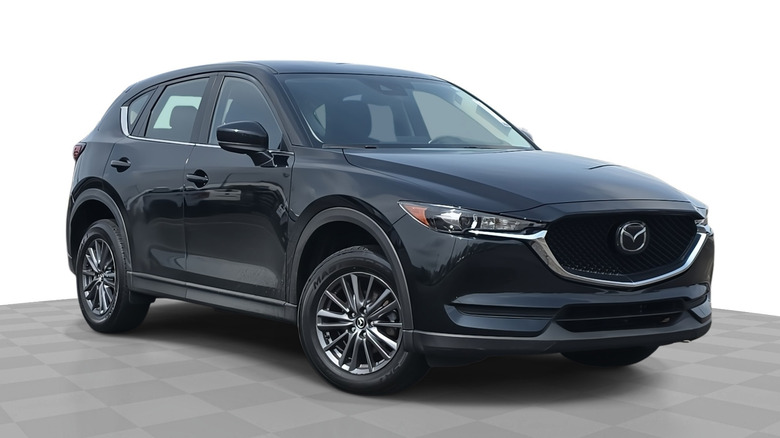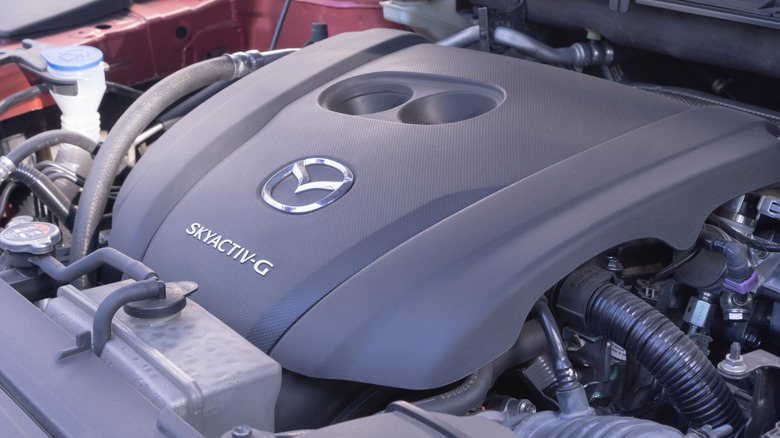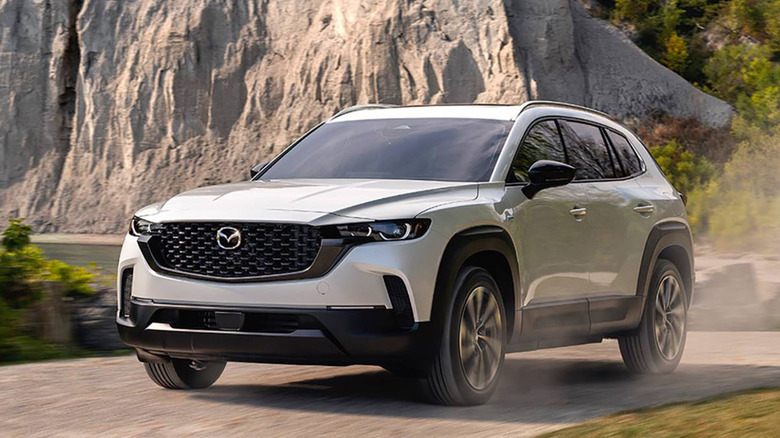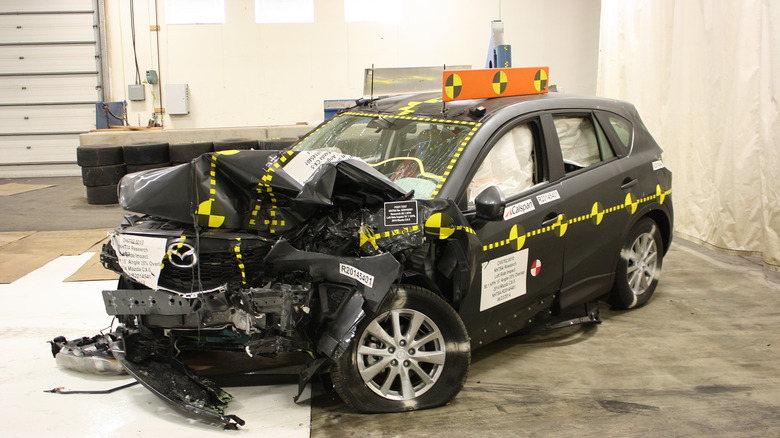10 Things You Should Know Before Buying A Mazda CX-5 (New Or Used)
Mazda spent the last few years overhauling its lineup. Such new editions include the CX-50 and the CX-70. Of course, with new cars comes the retirement of old vehicles and such is the case for the likes of the CX-9 among others. Some will go down as being classic cars in their own right. However, for the time being at least, Mazda has no plans to eliminate the CX-5, and for good reason. It's a surprisingly good SUV that is also quite fun to drive.
The evolution of the CX-5 took place in a relatively short period of time. It started as a concept car in 2010 before being released to the public in 2013. It is currently the most successful vehicle that Mazda makes, taking top spots in the U.S., Australia, New Zealand, and the Netherlands. Thus, it's only natural that people shopping for a smaller mainstream SUV would want to take a look at it. The vehicle focuses on different things than most of its competitors, giving consumers a truly unique option in a sea of typical crossover SUVs.
You are most likely here because you're shopping for a CX-5, and you want to learn more about it. Here are some things you should probably know about the CX-5 before heading to the dealership and trying one out for yourself. Our first bit of advice: you should definitely try one out before buying it.
People really like the Mazda CX-5
Mazda isn't the most popular automaker in the U.S. by a long shot, but the CX-5 has a loyal fan base. There are many reasons for this, and those are things we'll get to throughout this list. However, the most cited reason is because of the vehicle's driving dynamics. Mazda put a huge emphasis on this with the CX-5, which clashes with the big and cushy demeanor of the rest of the crossover segment. Per reviewers, the ride quality is firm, but still quite nice, and that sportier suspension tuning makes the car quite fun to drive.
The rest of the reasons will be explained below, but people who drive these things tend to really like them over competitors. Whereas most would be perfectly happy in a RAV-4 or a Honda CR-V, most of the Mazda fans we observed like the CX-5 for characteristics that you can only really get with the Mazda CX-5. For instance, many older CX-5 models don't have a touchscreen for the infotainment display and CX-5 fans like that quite a bit.
In short, if the CX-5 if your type of vehicle, you're going to be very happy with it. Mazda does several things differently from competitors, and that makes the CX-5 appealing for some drivers. Granted, the RAV-4 and CR-V outsell the CX-5 by leaps and bounds, but if you're in the market for something different, a CX-5 may be for you.
There are only two generations to choose from
Shopping for a Mazda CX-5 is fairly simple because there are only two generations to choose from. The nameplate started in 2013 and the first generation only lasted until 2016. Mazda's second generation started in 2017 and has been the same since. That means two things. One: other than tech upgrades, most CX-5s on the road today look alike. Two: shopping for one is surprisingly easy since the only real difference in model years are some tech add-ons dropped in over the years.
The good news is that both generations have the same underlying driving characteristics, so you can choose whichever one you want. First generation CX-5 models still boast the hallmark sporty driving, albeit with a slightly weaker engine. They even look similar, with the first generation having a few extra curves, especially around the front-end. In short, if you load a webpage with a bunch of used CX-5 models, it may be difficult to tell them apart.
However, of the two, we'd recommend the second generation. For starters, it's more likely you'll find newer used CX-5 models with lower mileage but also the improvement in things like engine selection, speaker quality, and driver assistance tech, and the inclusion of things like Android Auto and Apple CarPlay make the second generation the superior model. With that said, the first generation is still good if you want the simpler layout and don't mind less tech.
The most expensive CX-5 starts at $40,800
As a mainstream crossover, the Mazda CX-5 fits into a bunch of different price ranges. At its most expensive, the vehicle starts at $40,800 and with a few add-ons, can climb just over the $42,000 mark for the 2.5 Turbo Signature trim. For the money, you get some fancy stuff like Nappa leather seats that are also ventilated along with wood trim, a 360-degree camera, and some other goodies. It's expensive yes, but it's also competitively equipped for its price range.
If that's a bit too rich for your taste, the CX-5 has a little over half a dozen trim levels. The vehicle itself starts at $29,990 if you're shopping for one brand new. Most of the trims exist in the $30,000 to $40,000 range. Reviewers recommend something around the Preferred trim as it comes with some niceties like heated leather seats, a moonroof, and some other nice add-ons. So, in all, it's not the most expensive SUV you can buy in 2025, but not the least expensive either.
If you head to the used market, that's where things get interesting. We spent some time meandering around some used car websites and found that a used CX-5 is decently affordable. Since there are only two generations and the differences from one model year to the next aren't huge most of the time, that means you can find something with most of the features of a brand new CX-5 for vastly less money.
Less cargo capacity than some
Not everything is sunshine and rainbows for Mazda's sporty little crossover. Those looking for the maximum amount of cargo capacity will sadly want to look elsewhere. Among other things, the CX-5 is known for having smaller cargo capacity than its rivals. This is due to the CX-5's smaller stature. While it exists in the same class as the Honda CR-V and the Volkswagen Tiguan, the Mazda is shorter, which translates to less cargo capacity.
By the numbers, a Honda CR-V has around 36 cubic feet of storage while the Hyundai Tucson has around 41 cubic feet of space behind the seats. The Mazda CX-5 has about 29 cubic feet of storage. So, depending on how you measure, it's roughly 20 to 25% smaller than most of its competitors. Reviewers have recognized this as well, noting that the Mazda CX-5 is not the most practical when it comes to storage. It also has less headroom than some competitors, making it a bit of a tight squeeze for taller folks.
That isn't to say that the CX-5 is cramped. Neither of those are the case. However, if your primare concern is storage space and headroom, the CX-5 may be disappointing. If you're over six feet tall, it's certainly worth taking a test drive to see its proportions are right for you. Most people under six feet tall should be just fine.
Only 2024 models and newer have a touchscreen
One of the more interesting tidbits about the CX-5 is that many used models on the market don't have a touchscreen. Instead, Mazda has what it calls a Command Knob with buttons to help you navigate your infotainment display. The knob is located between the two front seats and can be reached with by hand without much struggle. The buttons add shortcuts to things like mute, the volume knob, navigation, and more so that you never have to reach to your dash.
This feature is, without a doubt, one of Mazda's most polarizing features. For some folks, the convenience and familiarity of a touchscreen trumps physical controls and may chase some buyers away. On the opposite end of the spectrum, the Command Knob has fans who swear up and down that it's superior to the touchscreen in every way. Their logic is sound. Once you learn how to use the command knob, you can use it without taking your eyes off the road and you can reach most basic controls without needing to move around in your seat while driving.
Fortunately, Mazda has heard the feedback and started integrating touchscreens on the CX-5 starting with the 2024 model year. Thus, if you're surfing for a used CX-5 on the open market, any model from 2023 on back will use the Command Knob exclusively, while the 2024 and newer models will have both touchscreen and Command Knob options.
The Mazda CX-5 is generally reliable
Reliability tends to be quite high among the CX-5s. It won't top charts, but it seems to always be in the conversation when it comes to reliable vehicles. In fact, Mazda is pretty good with reliability for most of its vehicles, including newer ones like the CX-50. Based on every piece of data we were able to scrape up, Mazda's reliability doesn't appear to be ad populum fallacy either. The brand just tends to make cars that last a long time.
So, let's go through some of that data. RepairPal ranks the CX-5 as the most reliable SUV in its weight class based on its average annual repair cost and number of breakdowns reported to the website. Since there are only 12 years of total data, we also checked every year against JD Power's rankings and every year turned out a good score. The second generation tends to do slightly better than the first generation but even the first generation had mostly good years. Everywhere we looked from companies online to anecdotal stories showed that people generally enjoy their CX-5 and find it quite reliable.
Now, we'll get into this more in a moment, but not every part of every CX-5 is perfect. Of course, it's also worth noting that reliability scores are predictions rather than anything else. You may find one that goes 300,000 miles or one that blows a gasket at 50,000. Every car brand has a level of randomness.
Be wary of the 2018-2021 models
There are a few model years that you may want to watch out for, and it's the 2018 to 2021 model years of the CX-5. In particular, you'll want to watch out for the models that have cylinder deactivation. This is fairly easy to spot. The naturally aspirated 2.5-liter four-cylinder has the deactivation while the turbo engine does not. So, if you're surfing for CX-5 models in the aforementioned years, you'll want to opt for the turbo. That is not the first time you'll hear us say that in this article, by the way. The turbo is pretty great.
So, here's what's up with the naturally aspirated 2.5-liter. There was a defect in the engine design that caused the engine to leak oil due to head gasket issues. These issues would manifest fairly early on in the life cycle of the engine. In one example, we found someone who had it happen with just 29,000 miles on the odometer. In Mazda's defense, cylinder deactivation is a technology many automakers struggle with, but it is still one that shoppers should be aware of before buying.
There is some good news, though. Mazda did extend its powertrain warranty for affected vehicles, so if you already bought one and this issue happens to you, you should be covered for the repair. However, you may need to either purchase a new Mazda or a certified pre-owned Mazda to reap the benefits. Those who purchased a used CX-5 can contact Mazda to see if the warranties are still intact.
You should get the turbo if you can
In general, there are two pros and one con to getting the turbocharged 2.5-liter over the naturally aspirated 2.5-liter. The first is avoiding the cylinder deactivation issues present in the 2018 to 2021 model years since the turbo engine doesn't have them. Buying a turbo avoids that situation entirely, leaving you free to shop for whatever model year you want. It's a smart decision, especially in the used market where the warranty may not be valid anymore.
The other reason is because it's simply better. Per reviewers, the naturally aspirated engine gets you to 60 MPH in about eight to nine seconds. The turbocharged engine reduces that to about 6.5 seconds, depending on who you ask. Those extra two seconds can certainly help when merging onto the freeway and passing vehicles once you're there. It's also been pointed out by virtually everyone who's driven the car that the turbo engine better pairs with the CX-5's driving dynamics since you can go fast in a car that also handles well. In short, why bother buying a car that can take corners like a demon if you don't have the engine to match?
As mentioned, there is one downside and that's the fuel economy. The naturally aspirated engine does 26 MPG in the city and 31 on the highway while the turbo reduces that to 22 and 27, respectively. Folks with a light foot can goose some pretty good fuel economy numbers out of the turbo engine, though.
Or wait for the hybrid version
Or, if you want to avoid the base engine, you can always wait one more year. Mazda has announced that the 2027 model year of the CX-5 will come with an optional hybrid powertrain. If Mazda does it the same way more other automakers do, the hybrid powertrain may not be quite as powerful as the turbo engine but it'll certainly do better than the base engine in terms of both power and fuel economy. Sure, it may not tow as well, but the Mazda CX-5 doesn't tow a ton of weight anyway (2,000 pounds), so you're not losing much.
The question mark is that nobody except Mazda knows what kind of hybrid powertrain the CX-5 will eventually get. About the only information available as of this writing is that it won't be the same hybrid system in the Mazda CX-50, which notably uses the same hybrid engine and setup as the Toyota Rav4. That system is quite excellent. For now, pundits are guessing that it'll likely incorporate the existing 2.5-liter SkyActiv engine that the CX-5 already uses.
That's not so bad since the engine issues appear to have been worked out. Mazda has been using the 2.5-liter and its turbo counterpart — along with a six-speed automatic transmission — since the second generation launched eight years ago. A hybrid powertrain would certainly bring the CX-5 up to date in terms of fuel efficiency, which is always a good thing.
An IIHS top safety pick
Nobody wants to talk about traffic accidents. Unfortunately, they happen, so it's always a good idea to buy a vehicle that will do everything it can to help you walk away clean from such an event. The CX-5 has been an IIHS Top Safety Pick+ — a step up from the regular Top Safety Pick — since 2015 and a regular Top Safety Pick for all the model years prior to 2015.
As with the reliability, we went ahead and looked at every model year of the CX-5 as judged by the IIHS since there are only a dozen or so models and what we saw was encouraging. The CX-5 started out well with mostly A-ratings for most crash test results. However, it did score poorly on its structure and safety cage ratings. For the uninformed, the structure and safety cage are the guts of the car that are supposed to protect you from collisions. This issue was remedied by the 2015 model year, which is when the CX-5 received its first Top Safety Pick+ rating.
From that year onward, the CX-5 hasn't had many lapses in safety. Some of the advanced safety tech could be better on more recent model years, but otherwise, there aren't any notable weaknesses in how Mazda builds these things. You can pretty much shop with confidence here as the CX-5 has scored well for a decade at this point.
